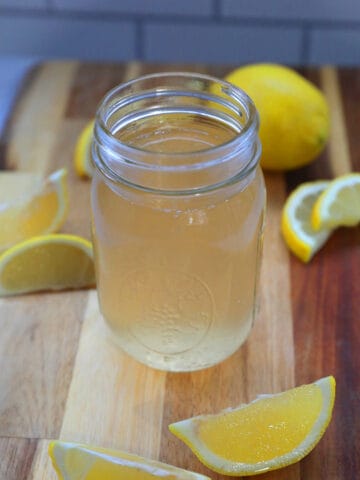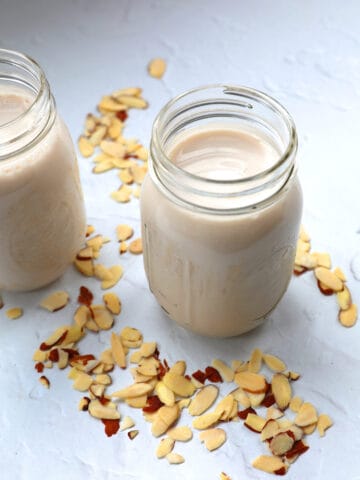With 7,500 varieties of apples grown around the world, it can be daunting to know which ones to choose if you want to make apple juice. This guide will cover the 8 best apples for juicing.

Let’s face it. Fresh just tastes better. That’s true when it comes to apple juice as well. So, if you’re considering making your own juice at home, it’s a good idea to start with the right apples.
Let’s take a look at the best apples for apple juice, along with what makes them the top picks.
Jump to:
What to look for in the apples
Some apples have certain characteristics that make them better candidates for juicing. In order to get the best juice, select apples that are:
Full of flavor: Apples with more natural flavor will create rich, luscious juices. You can always add flavor enhancers during the juicing process, but starting with the tastiest apples will often yield the best results.
Large: Bigger apples will generally produce more juice, so you’ll need fewer apples to begin with. This can be important with some of the more expensive apples.
Crisp: Fresh-tasting, crisp apples will add a nice level of tartness to the juice and balance out overly sweet flavors.
Solid: Firmer apples will hold up better to juicing than softer ones will, as the latter may simply turn to mush rather than yield juice.
1. Honeycrisp

Honeycrisp apples are the perfect balance of sweet, crisp, size, and solidity.
They’re among the tastiest apples available, and like their name implies, they’re also pleasantly crisp. Plus, the honey notes in these juicy apples lend a pleasant, balanced mellowness.
In addition, they’re large and firm — all factors that make them ideal for juicing.
The downside? They’re often among the most expensive due to the challenges in growing them. But if you want some seriously flavorful juice, Honeycrisp will not disappoint.
2. Granny Smith

Also on the larger side, Granny Smith apples are a favorite among bakers to use in apple pies, thanks to their zesty acidity. It’s that same tanginess in these green apples that helps make them great for juicing as well.
The acidity helps balance out the sweetness of the juice. And they have relatively low sugar content, which means they’re lower in calories than many other apple varieties.
3. Pink Lady

Pink Lady apples fall somewhere between Honeycrisp and Granny Smith when it comes to taste. They have a delicate sweetness to them, but also a noticeably tart flavor. These contrasts create a nice balanced juice, so they make Pink Lady a good juicing apple.
With a distinctive blush color, these apples are also crisp, very firm, and on the larger side. Use the skins during juicing to end up with a pretty pinkish hue to your juice.
4. Fuji

One of the more common, everyday apples, Fuji can easily be found at most any grocery store throughout the year. And it’s a good option for making apple juice.
They’re on the larger side, aren’t too sweet, and are relatively dense. And their mild palate and fresh taste means they can easily take on other flavors that you may want to add during juicing, like spices or other apples to make a blend.
Though they can fetch a slightly higher price than other types, Fuji apples are still relatively affordable.
5. Braeburn
Juicy and crispy, Braeburn apples have moderate acidity, so they produce a refreshing balance of tart and sweet. They also have spicier notes of cinnamon and nutmeg, which are reminiscent of apple cider.
It’s that harmony of flavors and textures that makes Braeburn a good apple for juicing as well.
While native to New Zealand, they’re now grown in various regions around the world. In the United States, they’re most commonly grown in Washington State and available most times of the year.
6. Gala

One of the most widely consumed apples, Galas are easy to find and inexpensive, so they’re a great apple option if you’re new to juicing and on a budget.
In terms of flavor profile, they’re not too sweet or tart, with a mild balanced taste and a crisp texture. They also have a floral aroma with hints of vanilla.
However, gala apples can be on the smaller size. And their white flesh can be a bit softer and bruise more easily than some other types, so you want to make sure you get very fresh apples if you intend to juice them.
7. Jazz
A cross between Gala and Braeburn, the Jazz apple is fragrant and fruity. It’s a bit tart with a sweet taste, and the juice tends to be zesty and effervescent.
While they can be on the smaller size, they still pack a flavorful punch, and they have a firm, crunchy flesh. They’re usually available year-round.
If you want to go a step beyond straight apple juice, try mixing some of these into smoothies or cocktails to add a delicious, fruity tang.
8. Red Delicious
Right up there in popularity with Gala is Red Delicious. These ubiquitous, sweet apples are notable for their deep red color and slightly unusual shape. Unlike rounder varieties, Red Delicious apples are narrow and taper at the bottom, often with distinct ridges near the top stem.
The flesh is juicy and crisp and the flavor is noticeably sweet, so if you like a more naturally sugary juice, this will be a good pick. And they’re always in season so you should have no problem finding them.
How to juice apples step-by-step
Step 1 – Like when working with almost any produce, you want to start by washing the fruit to remove any dirt or chemicals that may have been used during the growing process.
Step 2- Cut your apples into slices or chunks. I use an apple slicer to make things easier. No need to peel them; the juicer will remove the peels from the juice. But do discard the stem, seeds, and core.


Step 3 – Add the apple pieces to your blender or apple juicer.
Step 4 – If using a blender, add about half a cup of water to help add moisture and make the pulp less dense. About 3 apples will yield 1 cup of apple juice.


Step 5 – Any extra pulp and foam will oxidize and brown rapidly, so remove it by straining the juice with cheesecloth, a nut milk bag, or a metal strainer. This will also give you a smoother juice.
Step 6 – Pour in a glass or jar and enjoy!


Tips
💡 Don’t wait too long to drink the juice. Just as apples brown quickly after you slice them open, the same will happen to apple juice as oxidation sets in. So it’s best to drink within an hour of juicing. This will also provide the best flavor and the most nutritional value.
💡 Adding a bit of lemon juice can help delay oxidation.
💡 A great way to enhance the flavor of the juice is to add spices like cinnamon or ginger, or add some extra zing with a bit of orange peel. You can also blend in other fruit juices like pear or cranberry or simply different types of apples.
Notes: Don’t juice the stem, core, or seeds. These tougher parts of the apple won’t add good flavors and they may harm your juicer. Plus, apple seeds contain trace amounts of amygdalin, a compound that includes cyanide. In small amounts, it’s harmless, so a person would likely need to consume between 100 to 1,000 seeds to risk cyanide poisoning. But why take the chance?
FAQ
No, it’s not necessary to remove the peel before juicing apples. The juicer or blender will separate the peels for you. And the peel contains a lot of beneficial vitamins that won’t make it into your juice if you remove it.
Yes, you should remove the core before juicing. It can be difficult for some juicers to process and it won’t improve the flavor. Simply discard it after you’ve cut the apple into slices, along with the seeds and the stem.
About 3 apples will yield 1 cup of apple juice. Though how much juice you get will vary depending on whether you have a larger variety like Honeycrisp or Granny Smith.
Some apple producers will spray the fruit with a thin layer of paraffin to help with freshness and appearance. The wax makes the apples look shinier, but you’ll want to remove it if you intend to juice these apples, as it can diminish flavor and gum up your juicer. To remove the wax, dip them in a mix of hot water and apple cider vinegar for a few seconds, then wash off with cold water.
Store freshly made apple juice in an airtight container in the fridge. It will keep for up to 5 days, but you’ll notice some browning as the juice starts to oxidize. You can also freeze fresh juice in covered ice cube trays for up to 6 months.
More beverage answers
Get more answers to your beverage-related questions. Check out the posts below.






Leave a Reply